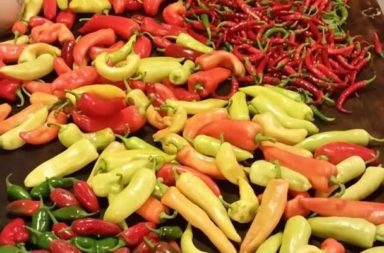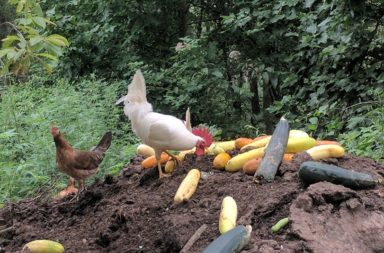Fruit trees are an excellent food source to add to your survival homestead. My fruit orchard here on our Appalachian homestead remains a work in progress. I only have three varieties of fruits that can be harvested so far, but am planning on planting more tree varieties in the coming spring. Even though my fruit grove is small, it is producing. Our peache and pear yield this year was bountiful.
It is essential to know what planting zone you live in before purchasing any trees to cultivate in your fruit orchard. I’m in Ohio, so I clearly can’t get an orange tree to grow – unless I purchase a dwarf tree and grow it indoors.
The second step to starting a fruit orchard is reviewing the amount of space that exists to properly grow fruit trees – big trees don’t grow well in tiny spaces. There are three different sizes of trees available to grow. You have the choice between dwarf (the smallest) to semi-dwarf, and then standard sized fruit trees.

There are also several different kinds of trees that produce fruit. There are stone fruit trees and pome fruit trees. Stone fruit trees produce a fruit with a stone in the center. The seed is inside the stone and will need cracked to get the seed out. Examples of stone fruits are peach, nectarines, plums, mangoes, and cherries.
Pome fruits trees are produced by flowering plants. These fruits produce a core of seeds in the center. They start as a cluster of flowers and each flower produces a bud. Examples of pome fruits are apples, pears, and loquats.
Pollination is the most important part in the fruit growing process. Some fruit trees are self-pollinators while others require cross-pollination with other cross-pollinator trees. Self-pollinating trees can also be cross pollinated. Cross pollination occurs when the pollen is transferred from one plant to another by a pollinator such as an insect or wind.
You should want to ask your local nursery about the pollination needs of the trees you are considering purchasing if you don’t know the vital fact about the variety you are interested in growing.
Orchard Location
There are specific requirements that an orchard needs to thrive, location being chief among them.
- Fruit trees need at least six hours of sunlight daily.
- Well drained soil is a must.
- Space is required for the tree to reach maturity and to keep them from throwing shade on each other.
The orchard on my homestead is in the shade first thing in the morning and then it is in full sun for the rest of the day. We had to cut down some trees to create a proper growing space for the fruit trees – but that was a welcomed chore because it garnered extra firewood to put up for winter.
Starting Trees From Seeds
Starting your own trees has been a struggle for me to master. I have nearly gave up before I came across some information detailing how to start trees through a process called stratification.
In simple terms, the seeds have to be in a cold moist environment to grow. You can plant the seeds right outside in the soil over the winter months. Just be sure to mark them so you know what you grew over the winter. I also plant them in flower pots and just stick them out on the back porch and come spring I have a little bitty tree. The cold, wet winter is the natural way of seed starting for your trees.
Another method that can be used to stratify trees is by putting the seeds in a baggie or bowl with some potting soil. Wet the soil slightly and then stick it in the refrigerator for four to six weeks. Be sure to label and date the container. I have left them in for longer than six weeks and the seeds just mushed up and were not suitable to use. Be sure not to make the soil too wet, that will also ruin the seeds. I have finally figured out how to stratify seeds successfully using this method, but still find it easier for to just put them in pots outside.

How To Plant Fruit Trees
- Choose your location.
- Dig the hole to twice the size of the root ball.
- Bury the tree to just beneath where the roots meet the tree.
- Fill the hole back in with the same dirt that came out of the hole.
- Water the tree.
- Stake the tree with a T-post or some rebar and tie it with some string so that it will grow straight.
- Leave the tag on the tree or at least record the breed of tree that was planted and its location for your records. I recommend recording your trees information because the tag will eventually likely fall off and be lost.
You don’t have to start your own trees from seeds or even young starts. You can purchase them from your local nursery or even online from a more cultivated stage – but the more advanced the tree, the higher the price tag. Always be sure that the fruit trees in your cart are the breeds that will thrive in your area.
Harvest Time
Not all fruits will ripen at the same time. To test the fruit for ripeness by looking at its color, size, and taste. Once a fruit becomes ripe it will not get any sweeter. The fruit will usually ripen within a two to three week span.
There are different varieties of fruit that ripen in different seasons. There are early season, mid-season, and late season harvest times. It is ideal to have trees that will ripen at different times so that you can enjoy each fruit and not be over ran with them all. You need to closely monitor the fruit grove and check each tree regularly to be make sure you do not miss the prime picking time.
After the fruit is harvested then you want to use it while it is still fresh. Cherries and plums will go bad quickly as their season of use isn’t that long. On the other hand apples and pears will last a little longer after picked. Be sure not to waste all of that delicious fruit, eat it, cook it or preserve it for later to make it a low-cost and shelf-stable survival food.
The harvest is the best time of the year in the fruit orchard for me. I love to harvest the food that my family and I have watched grow and cared for. My kids will snack as we pick. I just love to hear them talk about which fruit they think is better and see the pride in their eyes as the fruits of our labor have been realized.


